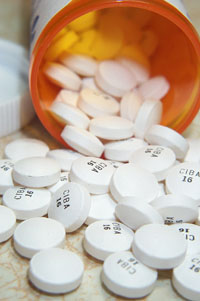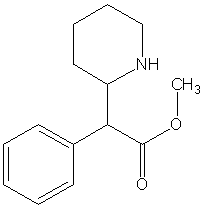* EVIDENCE-BASED ANSWER
Methylphenidate (Ritalin) is effective in the short-term treatment of attention deficit/hyperactivity disorder (ADHD) (strength of recommendation [SOR]: A, multiple randomized control trials).
Though the immediate-release preparation is the best studied of methylphenidate formulations, extended-release methylphenidate (Concerta) has similar benefits, with a dosing regimen that may better suit an adolescent lifestyle (SOR: B, based on extrapolation of 1 randomized controlled trial and expert opinion).
* EVIDENCE SUMMARY
The subjects of most ADHD medication studies have been school-age children. Most children with ADHD will have symptoms persisting into teenage years, and methylphenidate has been increasingly prescribed for them. (1,2) Various systematic reviews and meta-analyses have demonstrated the effectiveness of short-term methylphenidate in the treatment of adolescents with ADHD. (3-5) Most participants in these studies are males aged <13 years. Therefore, any conclusions about the effectiveness of methylphenidate in older adolescents must be inferred.
The most comprehensive systematic review found 8 well-controlled crossover trials with an average sample size of 24.8 (range, 9-48). (6) The average duration of the studies was 6 weeks. The majority of the participants were white males with a mean age of 13 years. Each study showed statistically significant improvement from treatment with methylphenidate. Average effect sizes were calculated for 3 domains: ADHD symptoms (0.94), social behavior (1.06), and academic performance (1.25). Effect sizes were calculated using a modified Cohen's d, which is the difference between the treated and untreated means divided by the standard deviation in the untreated condition. It is difficult to translate these changes in effect size into clinically meaningful outcome measures, although one rule of thumb estimates an effect size of 0.8 is moderate to large.
Of the 3 studies that reported the proportion of subjects with clinically significant improvement, the modal result was about one half showings improvement with methylphenidate. Of trials assessing dosing levels, <50% found significant differences between "low" and "high" doses. However, the researchers did not give their definition of low and high doses. Also, diminishing clinical improvement was noted with higher methylphenidate doses.
A single study on the once-daily stimulant preparation, extended-release methylphenidate, shows statistically significant improvement in adolescent ADHD. (7) In this multicenter, randomized, double-blind, placebo-controlled trial of 177 adolescents, subjects were given placebo (n=87) or extended-release methylphenidate (n=90) at titrated doses from 18 mg/d to 72 mg/d. Following a subsequent 2-week randomization phase, clinical investigators found extended-release methylphenidate significantly superior to placebo (P=.001) on the ADHD scale. Subjects also rated it significantly superior to placebo (P=.001) on the Conners-Wells' Self-Report Scale. Mean dose and average age were not reported. This study has been presented as an abstract and is not yet published.
* RECOMMENDATIONS FROM OTHERS
The American Academy of Child and Adolescent Psychiatry (AACAP) supports the prescribing of methylphenidate in adolescents with ADHD. (8) Given the unique psychosocial, environmental, and scheduling challenges of adolescence, the AACAP mentions extended-release methyl-phenidate as "well-suited for treatment of adolescents."
Timothy F. Mott, MD, Navy Hospital Pensacola Family Practice Residency, Pensacola, Fla; Laura Leach, MLIS, Carolinas Healthcare System, Charlotte AHEC, Charlotte, NC
* CLINICAL COMMENTARY:
Patients with childhood ADHD usually benefit from continuing their medication
Adolescents must face the challenge of becoming more organized and independent to be successful in middle school and high school. Those with childhood ADHD may have a particularly difficult transition, and will usually benefit from continuing to take their stimulants. Some adolescents, who were not previously identified as having ADHD, may declare themselves at this age due to school performance issues. Careful evaluation and treatment of these patients will contribute to their success.
Physicians should use the lowest effective dose of methylphenidate, as the studies seem to indicate that higher dosages do not improve performance in adolescents. Teens often prefer long-acting preparations, which obviate the need to take medication at school. The studies reviewed do not define long-term academic or vocational success, which is a more important outcome than symptom control for adolescents.
Lisa Johnson, MD, Providence St. Peter's Family Practice Residency, Olympia, Wash
REFERENCES
(1.) Safer DJ, Zito JM, Fine EM. Increased methylphenidate usage for attention deficit disorder in the 1990s. Pediatrics 1996; 98:1084-1088.
(2.) Fischer M, Barkley RA, Edelbrock CS, Smallish L. The adolescent outcome of hyperactive children diagnosed by research criteria: II. Academic, attentional, and neuropsychological status. J Consult Clin Psychol 1990; 58:580-588.
(3.) Klassen A, Miller A, Raina P, Lee SK, Olsen L. Attention-deficit hyperactivity disorder in children and youth: a quantitative systematic review of the efficacy of different management strategies. Can J Psychiatry 1999; 44:1007-1016.
(4.) Schachar R, Jadad AR, Gauld M, et al. Attention-deficit hyperactivity disorder: critical appraisal of extended treatment studies. Can J Psychiatry 2002; 47:337-348.
(5.) Schachter HM, Pham B, King J, Langford S, Moher D. How efficacious and safe is short-acting methylphenidate for the treatment of attention-deficit disorder in children and adolescents? A meta-analysis. CMAJ 2001; 165:1475-1488.
(6.) Smith BH, Waschbusch DA, Willoughby MT, Evans S. The efficacy, safety, and practicality of treatments for adolescents with attention deficit/hyperactivity disorder (ADHD). Clin Child Fam Psychol Rev 2000; 3:243-267.
(7.) Greenhill LL. Safety and Efficacy of OROS MPH in Adolescents with ADHD. Program and Abstracts of the American Psychiatric Association, 156th Annual Meeting; Scientific and Clinical Reports. May 17-22, 2003; San Francisco, Calif. Abstract S&CR12-37.
(8.) Greenhill LL, Pliszka S, Dulcan MK, et al. Practice parameter for the use of stimulant medications in the treatment of children, adolescents, and adults. J Am Acad Child Adolesc Psychiatry 2002; 41 (2 Suppl):26S-49S.
COPYRIGHT 2004 Dowden Health Media, Inc.
COPYRIGHT 2004 Gale Group




